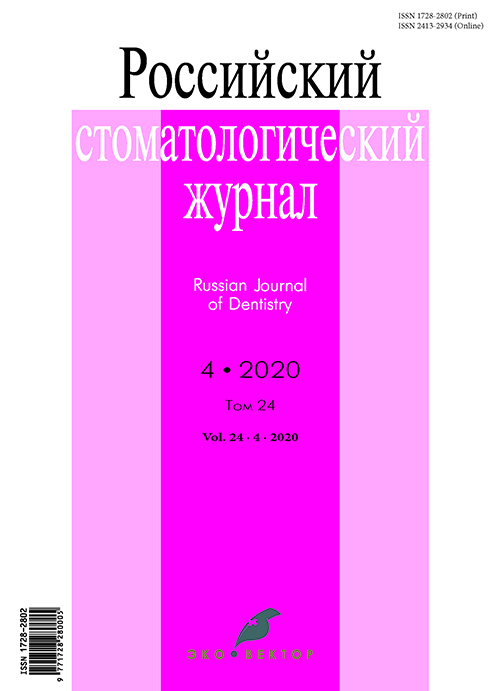Использование междисциплинарного подхода к реабилитации пациентов, нуждающихся в тотальной реконструкции зубных рядов (клинический случай)
- Авторы: Утюж А.С.1, Дзалаева Ф.К.1, Чикунов С.О.1,2, Михайлова М.В.3, Будунова М.К.1
-
Учреждения:
- ФГАОУ ВО «Первый Московский государственный медицинский университет им. И.М. Сеченова», Минздрава России (Сеченовский университет)
- ФГАОУ ВО «Российский университет дружбы народов» (РУДН)
- 1 ФГАОУ ВО «Первый Московский государственный медицинский университет им. И.М. Сеченова», Минздрава России (Сеченовский университет)
- Выпуск: Том 24, № 4 (2020)
- Страницы: 240-246
- Раздел: Клинические исследования
- Статья получена: 16.12.2020
- Статья одобрена: 16.12.2020
- Статья опубликована: 15.08.2020
- URL: https://rjdentistry.com/1728-2802/article/view/55268
- DOI: https://doi.org/10.17816/1728-2802-2020-24-4-240-246
- ID: 55268
Цитировать
Полный текст
Аннотация
Цель исследования — апробация алгоритма комплексного клинического, функционального и инструментального анализа при лечении пациентов с необходимостью тотальной реставрации зубных рядов.
Материал и методы. Предложена система реабилитации пациентов с адентией, которого при планировании коррекции прикуса следует учитывать данные объективного обследования пациентов, полученные с использованием комплекса диагностических методов. Особое внимание уделяется оценке функции височно-нижнечелюстного сустава и наличию патологических признаков нарушений состояния мышц челюстно-лицевой области.
Результаты. Представлена характеристика клинического случая — описание результатов диагностики и лечения пациента, которому ранее пациенту в одной из клиник были установлены имплантаты без выполнения необходимого объема диагностики и использовании операционного шаблона. Охарактеризован комплекс диагностических и лечебных мероприятий на основании данных клинического, функционального и инструментального анализа, полученных с помощью методов кондилографии и цефалометрии. Результаты лечебно-реабилитационных мероприятий позволили достичь оптимального распределения нагрузок на зубочелюстную систему, улучшилась гигиена полости рта. Используемый подход позволил своевременно корректировать функциональные и эстетические нарушения.
Заключение. Алгоритм работы с пациентами, нуждающимися в тотальной реставрации зубных рядов, должен включать тщательное изучение анамнеза, клинический функциональный анализ с использованием методов кондилографии, анализ моделей с целью регистрации и оценки статических и динамических соотношений зубных рядов, оценку цефалометрических и эстетических характеристик. Разработанный алгоритм является анатомически и патогенетически обоснованным, поскольку учитывает всю полноту изменений и взаимосвязей структур зубочелюстной системы и других систем организма, которые лежат в основе клинических проявлений у пациентов с адентией, нуждающихся в тотальной реставрации зубных рядов.
Полный текст
Об авторах
А. С. Утюж
ФГАОУ ВО «Первый Московский государственный медицинский университет им. И.М. Сеченова», Минздрава России (Сеченовский университет)
Email: dzalayevaf1626@bk.ru
Россия, 119146, г. Москва
Фатима Казбековна Дзалаева
ФГАОУ ВО «Первый Московский государственный медицинский университет им. И.М. Сеченова», Минздрава России (Сеченовский университет)
Автор, ответственный за переписку.
Email: dzalayevaf1626@bk.ru
ORCID iD: 0000-0002-3721-3793
SPIN-код: 6498-6901
кандидат медицинских наук, преподаватель кафедры ортопедической стоматологии
Первого МГМУ им. И.М. Сеченова
С. О. Чикунов
ФГАОУ ВО «Первый Московский государственный медицинский университет им. И.М. Сеченова», Минздрава России (Сеченовский университет); ФГАОУ ВО «Российский университет дружбы народов» (РУДН)
Email: dzalayevaf1626@bk.ru
Россия, 119146, г. Москва; 117198, г. Москва
М. В. Михайлова
1 ФГАОУ ВО «Первый Московский государственный медицинский университет им. И.М. Сеченова», Минздрава России (Сеченовский университет)
Email: dzalayevaf1626@bk.ru
Россия, 119146, г. Москва
М. К. Будунова
ФГАОУ ВО «Первый Московский государственный медицинский университет им. И.М. Сеченова», Минздрава России (Сеченовский университет)
Email: dzalayevaf1626@bk.ru
Россия, 119146, г. Москва
Список литературы
- Семенюк В.М., Ахметов Е.М., Федоров В.Е., Качура Г.П., Ахметов С.Е. Результаты организации, эффективности ортопедического лечения и качества зубных протезов (данные социологического исследования). Институт стоматологии. 2017;(1): 26–9.
- Булычева Е.А. Дифференцированный подход к разработке патогенетической терапии больных с дисфункцией височно-нижнечелюстного су-става, осложненной гипертонией жевательных мышц: Автореф. дис. … д-ра мед. наук. СПб.; 2010. 28 с.
- Рубникович С.П., Хомич И.С. Восстановление функции и эстетики зубочелюстной системы стоматологического пациента с применением хи-рургических и ортопедических методик и цифровых технологий. Стоматолог. Минск. 2018;(1):32–47.
- Ларькина Е.А. Эффективность сотрудничества ортодонта и ортопеда-стоматолога в процессе лечения комплексной патологии. Бюллетень медицинских интернет-конференций. 2014;4(4):346.
- Dolce M.C., Aghazadeh-Sanai N., Mohammed S., Fulmer T.T. Integrating oral health into the interdisciplinary health sciences curriculum. Dent. Clin. North Am. 2014;58:829–43. doi: 10.1016/j.cden.2014.07.002.
- Chatzopoulos G.S., Wolff L.F. Symptoms of temporomandibular disorder, self-reported bruxism, and the risk of implant failure: a retrospective analysis. Cranio. 2020;38(1):50–7. doi: 10.1080/08869634.2018.1491097.
- Грабков Ю.П., Гаврилов В.А., Романьков И.А. Критерии эстетической нормы стоматологических реставраций в системе координат лицевой симметрии и наш опыт эстетического протезирования зубов. Морфологический альманах имени В.Г. Ковешникова. 2019;17(2):94–102.
- Будный А.А., Плодистая И.Д. Современные технологии в ортопедической стоматологии. Бюллетень медицинских интернет-конференций. 2018;8(7):288.
- Чикунов С.О., Трезубов В.В., Булычева Е.А., Алпатьева Ю.В. Щадящий способ протезирования без предварительной подготовки опорных зу-бов. Институт стоматологии. 2012;(2): 52–3.
- Трезубов В.Н., Чикунов С.О., Булычева Е.А., Алпатьева Ю.В., Булычева Д.С. Поступательное моделирование зубных рядов при сложной клини-ческой картине. Клиническая стоматология. 2017;(3):60–3.
- Булычева Е.А., Чикунов С.О., Алпатьева Ю.В. Разработка системы восстановительной терапии больных с различными клиническими формами заболеваний височно-нижнечелюстного сустава, осложненных мышечной гипертонией (часть II). Институт стоматологии. 2013;(1):76–7.
- Tosun H., Kaya B. Effect of maxillary incisors, lower lip, and gingival display relationship on smile attractiveness. Am. J. Orthod. Dentofacial. Orthop. 2020;157(3):340–7. doi: 10.1016/j.ajodo.2019.04.030.
- Kalia R. An analysis of the aesthetic proportions of anterior maxillary teeth in a UK population. Br. Dent. J. 2020;228(6):449–55. doi: 10.1038/s41415–020–1329–9.
- Souza M., Cavalheiro J.P., Bussaneli D.G., Jeremias F., Zuanon A.C. Esthetic reconstruction of teeth with enamel hypoplasia. Gen. Dent. 2020;68(2):56–9.
- Augusti D., Augusti G., Ionescu A., Brambilla E., Re D. Natural tooth pontic using recent adhesive technologies: an esthetic and minimally invasive prosthetic solution. Case Rep. Dent. 2020;5:7619715. doi: 10.1155/2020/7619715.
- Gil-Martinez A., Paris-Alemany A., Lopez-de-Uralde-Villanueva I., La Touche R. Management of pain in patients with temporomandibular disorder (TMD): challenges and solutions. J. Pain Res. 2018;11:571–87. doi: 10.2147/JPR.S127950.
- Saga A.Y., Araujo E.A., Antelo O.M., Meira T.M., Tanaka O.M. Nonsurgical treatment of skeletal maxillary protrusion with gummy smile using headgear for growth control, mini-implants as anchorage for maxillary incisor intrusion, and premolar extractions for incisor retraction. Am. J. Orthod. Dentofa-cial. Orthop. 2020;157(2):245–58. doi: 10.1016/j.ajodo.2018.09.021.
- Утюж А., Юмашев А., Михайлова М. Ортопедические конструкции из сплавов титана при непереносимости традиционных зубных протезов. Врач. 2016;(7):62–4.
- Karthik K.V., Padmaja B.I., Babu N.S., Haritha J., Nikhil M., Priya K.S. Evaluation of esthetics of incisor position in relation to incisive papilla to replicate in the denture prosthesis. J. Family Med. Prim. Care. 2020;9(1):298–302. doi: 10.4103/jfmpc.jfmpc_772_19.
- Revilla-Leon M., Campbell H.E., Meyer M.J., Umorin M., Sones A., Zandinejad A. Esthetic dental perception comparisons between 2D- and 3D-simulated dental discrepancies. J. Prosthet. Dent. 2020; S0022–3913(19)30752–8. doi: 10.1016/j.prosdent.2019.11.015.
Дополнительные файлы
















